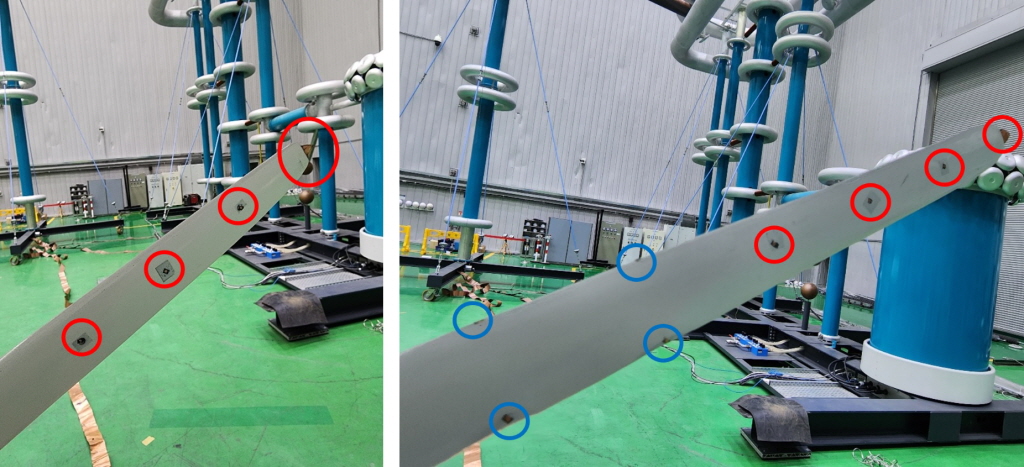한국전기연구원(KERI) 전기환경연구센터 우정민 박사팀이 겨울철 해상풍력단지에서 빈번하게 발생하는 정극성(+) 낙뢰 피해를 막을 수 있는 세계 최초의 기술을 개발하며, 풍력 발전기의 안정성 및 효율성을 높여 재생에너지 확대에 기여할 것으로 기대되고 있다.

▲기존 풍력 블레이드 수뢰부(왼쪽), 정극성 낙뢰 피해를 막기 위해 KERI가 가장자리 위치(파란색)에 새롭게 설계한 수뢰부(오른쪽)
우정민 박사팀, 세계 최초 정극성 낙뢰 방어 기술 개발
풍력 발전기 안정성·효율성 높여 재생에너지 확대 기여
겨울철 낙뢰에 더 약한 풍력 발전기의 피해를 막는 기술이 개발되며, 풍력 발전기의 안정성 및 효율성을 높여 재생에너지 확대에 기여할 것으로 기대되고 있다.
한국전기연구원(KERI)은 전기환경연구센터 우정민 박사팀이 겨울철 해상풍력단지에서 빈번하게 발생하는 정극성(+) 낙뢰 피해를 막을 수 있는 세계 최초의 기술을 개발했다고 16일 밝혔다.
낙뢰는 전압이 +극과 -극이 존재하듯이 정극성과 부극성으로 나뉜다.
정극성 낙뢰는 구름이 양전하를 띠고 지면이 음전하를 띠는 경우 발생하며, 부극성 낙뢰에 비해 발생 확률은 낮지만 전류의 세기가 매우 크다. 특히 겨울철에 구름의 고도가 낮아지면서 정극성 낙뢰가 주로 발생한다.
최근 신재생에너지 수요 증가와 함께 풍력 발전기의 건설이 급증하고 있다. 특히 한국은 저풍속 환경에 특화된 대형 풍력 터빈이 바다에 많이 건설되고 있다.
반면에 해상풍력발전은 높은 타워 구조로 인해 낙뢰에 매우 취약하다. 낙뢰로 인한 블레이드 손상은 풍력 발전기의 중단과 복구 비용을 유발하며 큰 피해를 초래한다.
우정민 박사팀은 정극성 낙뢰로부터 풍력터빈 블레이드를 보호하는 새로운 설계법을 고안했다.
기존 블레이드에도 낙뢰 피해를 최소화하는 수뢰부가 있지만, 정극성 낙뢰에 대해서는 방호 효율이 낮았다.
이를 해결하기 위해 팀은 다양한 조건과 블레이드의 회전 각도, 재질 등을 철저히 분석했다.
그 결과 정극성 낙뢰는 기존 수뢰부를 피하고 블레이드 옆 가장자리에 내리친다는 사실을 확인했다.
연구팀은 축소 모형을 제작하고 고해상도 카메라를 이용한 인공낙뢰 실험을 반복적으로 수행했다.
이를 통해 블레이드 옆 가장자리에 수뢰부를 최적으로 위치시키는 새로운 설계법을 개발했다.
이 방법은 정극성 낙뢰의 전하 분포를 제어해 피해를 최소화할 수 있음을 확인했다.
우정민 박사는 “풍력터빈 블레이드의 정극성 낙뢰 대책을 설계하고 실험적으로 검증한 기관은 전 세계에서 우리가 유일하다”며 “이번 연구가 풍력 발전기의 안정성과 효율성을 높여 재생에너지 보급 확대에 기여할 것”이라고 밝혔다.
이 연구는 재생에너지 분야 상위 5% 국제 학술지 ‘Results in Engineering’에 게재됐고, 국제대전력망협의회(CIGRE)의 공식 저널에도 기고됐다.
KERI는 실제 규모의 풍력 블레이드에 설계법을 적용해 추가 실험 데이터를 확보하고, 관련 특허 등록 및 기업체 기술 이전을 추진할 계획이다. 향후, 풍력 외에도 고층 건축물, 통신탑, 해양 구조물 등 낙뢰에 취약한 분야에 연구 범위를 확대할 예정이다.
이번 연구는 과학기술정보통신부 국가과학기술연구회 산하의 정부출연연구기관인 KERI와 한국에너지기술평가원의 ‘대규모 해상풍력 발전단지 낙뢰 대책 플랫폼 기술 개발’ 사업의 지원으로 진행됐다.
